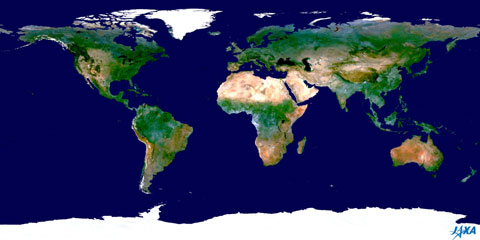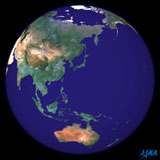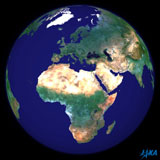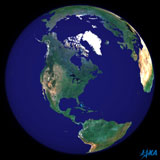Seen from Space 2005
What color is the Earth's surface?
- Cloud-free global land-surface images from GLI. -
JAXA EORC produces true-color global images using Earth-observation satellites that continually observe the Earth's surface from orbit. We have released global cloud-free images (as Fig. 1) produced using ADEOS-II GLI data. In Fig. 1, the white area in the upper left is Greenland, and that in the lower left is Antarctica. The yellow or brown area in the center is the Sahara desert of northern Africa. We can see that the arid or semi-arid areas in the Arabian Peninsula, Central Asia, Australia, eastern and southern Africa, western North America, and South America have expanded from the yellow or brown areas. The deep green of other land areas indicates rich vegetation.
Figures 2 to 4 are spherical projected images using Fig. 1, with the center being Japan, Europe, and North America. How many days does an Earth-observation satellite require to completely observe the Earth's surface? It depends on the satellite's characteristics, such as orbit and observation mode. ADEOS-II GLI requires about three days. However, satellites can not obtain the same images every day due to the many clouds. We know the seasonal variations of the Earth's surface, because we can feel them in our daily life. This image of the Earth is composed of about 2200 low cloud-influenced images chosen from many observation images acquired by ADEOS-II GLI from April to October 2003.
|
|||||||||||||||||||







